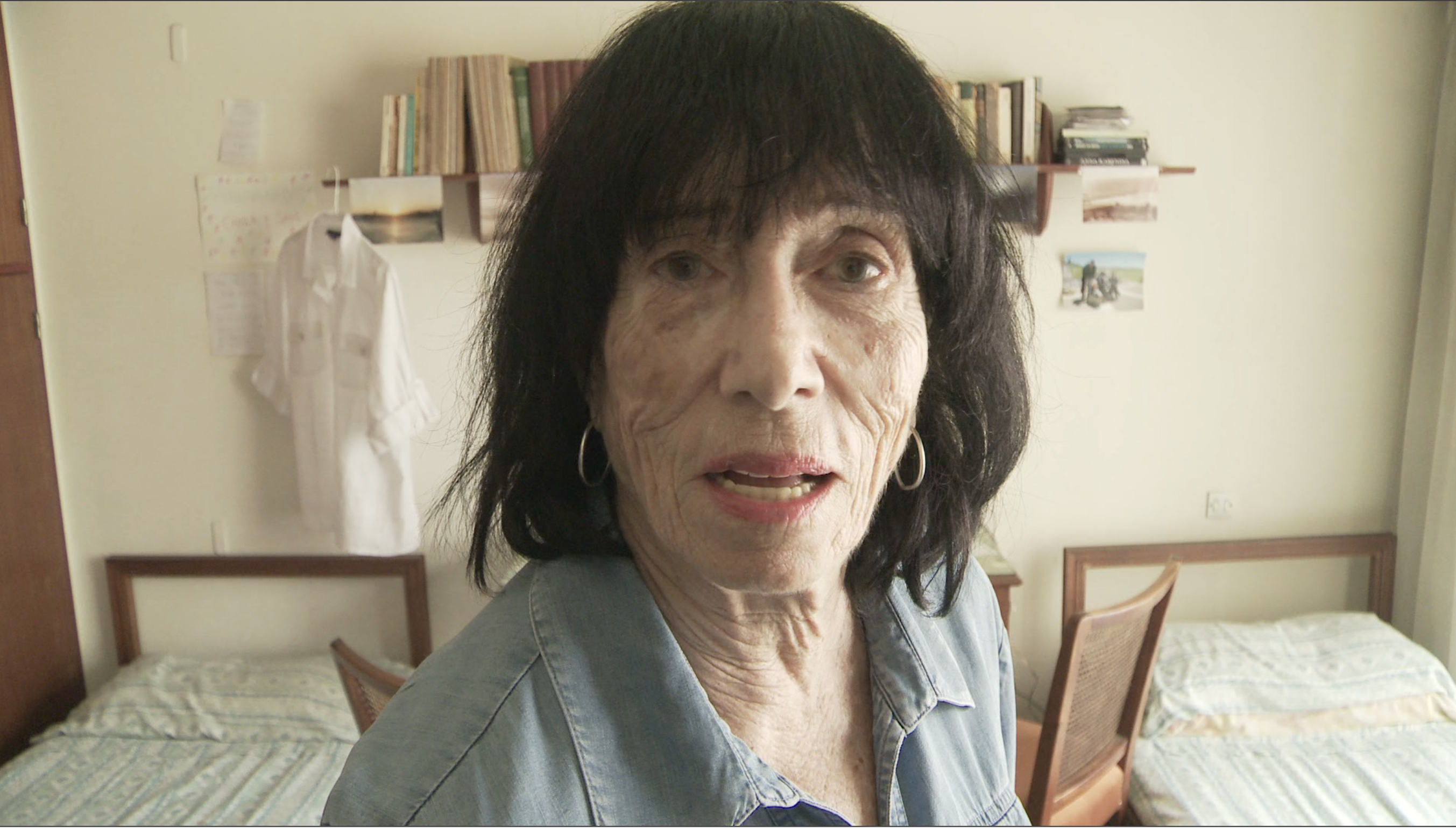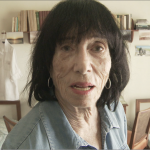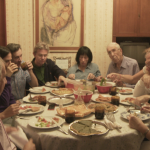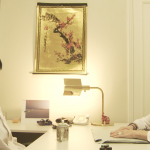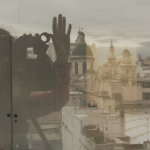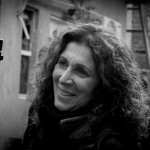My Hist(e)ry in the cinema
– Technical Information / Información Técnica:
(2016) – 01:04:00 – Argentina – NTSC – 24 fps – HD – 1920*1080 – Colour – Documentary
– Logline:
María Victoria, a film director, decides to give up her career because of the uncountable difficulties that her job entails. Convinced by her friend Franca, she starts to film fun and emotional scenes of her daily life, that slowly and almost unintentionally lead her to reconnect with herself and with her true love for the cinema.
María, directora, harta del tiempo que le lleva realizar películas y de las dificultades para estrenar, abandona el cine. Fran, su amiga, la invita a que filme escenas cotidianas para reconectarse con su profesión.
– Synopsis / Sinopsis:
María, directora de cine, harta del tiempo que le lleva realizar películas y de las dificultades para estrenar, abandona el cine. Fran, su amiga, la invita a que filme escenas cotidianas de su vida. María filma a su marido, ex productor, que abandonó el cine para no divorciarse, a su hija, a quien explotan en la publicidad y al hijo que triunfa en YouTube. Registra a sus padres ancianos, personas apasionadas por el cine. Este camino la llevará a reencontrarse con ella misma y su eterna pasión por el cine.
– Long Synopsis / Sinopsis Larga:
María Victoria, filmmaker of many fiction films, feels frustrated by the difficulties of making and releasing a film in her own country. Her idea is to abandon the film industry, and she actually has a plan to associate with an art bookstore. She feels that the time it takes her to film each movie is no longer suitable to her age and patience, that she needs to work on smaller projects and to look for more immediate satisfactions. Franca, her friend and documentary maker, encourages her to film scenes of her daily life with a small camera, as she would be able to find ideas to reconnect with the cinema from a more relaxed, emotional, and why not, humorous point of view. Camera in hands, María Victoria will film fun gatherings of her cinephile family; daily situations with her husband (former film producer that gave up the cinema to avoid getting divorced); her daughter, tired of being exploited when working in advertising; her son, who adapted to the new audiovisual technologies and now triumphs by showing his content on YouTube; another daughter who is a psychologist and feels she doesn’t belong to the film industry, and she’s tired that her family only talks about cinema; and finally a fourth son that unconditionally supports María Victoria to keep up her career. On the other hand, she also films unique conversations and situations of her parents, an elderly couple that never loses their passion for the cinema and the willingness to constantly argue with each other. They have good memory about the history of the cinema, but at the same time they are modern and watch movies downloaded from the internet, and are not afraid of buying a fake DVD copy of a film, which is the contrary to María Victoria, who is a passionate for the old-fashioned way of watching films. Throughout this journey, who will also participate are her grandchildren, who show their passion for the cinema at the movie theaters, but also when they play movie games on a tablet. Eventually, she will receive “signals” that will make her recognize that the cinema is her big passion. Surprisingly, “Bambi” reappears in her life, making her cry like when she was a little girl. “Lawrance of Arabia,” the movie that inspired her to study cinema, is a leitmotiv of images and music that will replicate throughout her journey, as well as the documentary “Les Plages” by Agnes Varda will show her new language perspectives about the film industry. The journey that she will experience by filming all these scenes will reunite her with that little girl passionate for the cinema that she once was and that she will always be.
María Victoria, realizadora de varias películas de ficción, se siente frustrada por las dificultades de realizar y estrenar una película en su propio país. Su idea es abandonar el cine y de hecho ya tiene planes para asociarse a una librería de arte. Siente que el tiempo que le lleva realizar cada película, ya no se ajusta a su edad y su paciencia, que debe hacer proyectos más breves y buscar satisfacciones más inmediatas. Franca, su amiga documentalista, la incita a que con una cámara filme escenas de su vida cotidiana, que allí puede haber ideas para volver a conectarse con el cine, desde un lugar más relajado, emotivo y por qué no, desde el humor. Cámara en mano, María Victoria irá recorriendo divertidos encuentros familiares de su cinéfila familia. Situaciones cotidianas con su marido, ex productor de sus películas, que abandonó el cine para no divorciarse. Una hija cansada de que la exploten trabajando en publicidad, un hijo que se adaptó a las nuevas tecnologías audiovisuales y triunfa exhibiendo sus contenidos en YouTube. Otra hija psicóloga que no se siente parte del mundo del cine, y está cansada que el cine sea el único tema de conversación familiar y un cuarto hijo que la apoya incondicionalmente a que siga con su profesión. Por otro lado filma insólitas conversaciones y situaciones con sus padres, dos personas entradas en edad que no pierden la pasión por el cine ni las ganas de discutir entre ellos. Dos memoriosos de la historia del cine pero super agiornados a la hora de ver películas bajadas por la web, y a los cuales no les tiembla el pulso para comprar una película trucha. Contrariamente a María Victoria que vive aferrada a la antigua forma de ver cine. En el recorrido aparecerán sus nietos, que adoran el cine, tanto en las salas como en los jueguitos de las tablets. De a poco irá recibiendo “señales” que la harán reconocer que el cine es su gran pasión. Sorpresivamente “Bambi” reaparece en su vida haciéndola llorar como cuando era una nena, “Lawrence de Arabia”, la película que la llevó a estudiar cine es un leitmotiv de imágenes y música que se reiterarán en su camino, así como el documental de Agnes Varda “Les Plages” le abrirá nuevas perspectivas de lenguaje en el cine. Finalmente María Victoria consultará a una médica China por sus contracturas, producto de su stress por el cine. Muy a su pesar la médica no le recetará ningún tipo de remedio, sino simplemente la hará reflexionar acerca de la Muralla China y la verdadera esencia del tiempo. Este recorrido que transita a través de sus notas fílmicas la rencontrará con esa niña apasionada por el cine que fue alguna vez y que aún perdura en ella, más viva que nunca.
– Director´s Biography / Biografía del Director:
MARÍA VICTORIA MENIS
María Victoria Menis is Argentinian, she studied film at the ENERC. Writer of film, theater and television. She teaches in University of Buenos Aires, Enerc and Film School Avellaneda.
His first short film won the prestigious Melies Award. His feature films “Los Espíritus Patrióticos”, “Arregui, la Noticia del Día”, “El Cielito”, “La Cámara Oscura” and “María y el Araña” received rave reviews and toured numerous festivals and has won major awards.
On stage, his works «Lágrimas en el Sahara» and «Gamuza» won the National Playwriting Award and Argentores being represented their parts in Cervantes National Theater and the San Martín Theatre Complex. On television he wrote and directed two programs that won the Martin Fierro Award, «Cosecharás tu Siembra» and “Más allá del Horizonte”.
María Victoria Menis es argentina, estudió cine en el ENERC. Guionista de cine, teatro y televisión. Docente de la Universidad de Buenos Aires, Enerc y Escuela de Cine de Avellaneda.
Sus primeros cortometrajes ganaron el prestigioso Premio Méliés. Sus largometrajes, ¨Los Espíritus Patrióticos¨, ¨Arregui la Noticia del Día¨, ¨El Cielito¨, ¨La Cámara Oscura¨ y “María y el Araña”, obtuvieron excelentes críticas y recorrieron numerosos festivales obteniendo importantes premios.
En teatro, con sus obras «Lagrimas en el Sahara» y «Gamuza» obtuvo el Premio Nacional de Dramaturgia y el Premio Argentores, siendo representadas sus piezas en el Teatro Nacional Cervantes y en el Complejo Teatral San Martín. En televisión escribió y dirigió en dos programas que obtuvieron el Premio Martin Fierro, «Cosecharás tu siembra» y «Más allá del horizonte¨.
«Mi hist(e)ria en el cine» es su primer documental. Ha participado en los en los Work in Progress del Festival de Mar del Plata (Argentina), La Orquídea de Cuenca (Ecuador), DocProgress Buenos Aires (Argentina) obteniendo varios premios de post-producción.
– Filmography / Filmografía:
FEATURE FILMS
Los Espíritus Patrióticos (1989)
Arregui, la noticia del día (2001)
El Cielito (2004)
La cámara oscura (2008)
María y el Araña (2013)
SHORT FILMS
Velas (1977)
Árboles enanos (1977)
Talleres (1978)
Manantial (1981)
Vecinas (1984)
¿A qué hora? (1985)
Planta Potabilizadora (1986)
– Director Statement / Declaraciones del Director:
POINT OF VIEW
The documentary proposes that María Victoria herself grabs a camera and films the situations. Evidently, she has an absolute point of view in this documentary. Franca, her friend, has suggested to María Victoria that she films her own daily life, things that are interesting to her, and even situations that she may consider of minor importance. The point of view adopted by the camera will depend exclusively on María Victoria. When, for example, she films someone talking to her, the camera will take a close-up of the interlocutor or his/her hands, or focus on a long shot, or she will even position the camera on something that interests her. In that sense, when María Victoria hands the camera to her daugther Cecilia, the latter will adopt a different point of view, either on a new situation or at the same scenarios or characters filmed by Maria Victoria. The interlocutor(s) will be of extremely importance from the point of view of María Victoria. She will focus on their faces. She will follow them in different actions, always trying to respect their movements, their quietness, their words or silences. She will portray the scenarios where the documentary takes place: her parents’ house, with its wide bookstores, their disks, DVDs, their computer, as well as parts of her own house. She will also film the intimacy of her computer’s screen (in which she will write or contemplate fragments of her films), film stores on Lavalle Street, and cans piled up on the shelves of her film library. Maybe some new scenarios may show up, brought up by the protagonists, or because María Victoria needs to go around them. In some cases, María Victoria will investigate places and characters and her camera will adopt a more impartial style, as in a traditional documentary. For example, when she interviews the cook at the hippy fair of Plaza Francia. In other cases, the opposite will take place. Maria Victoria’s subconscious will burst reflecting dream-like scenes, such as a screening of «The 400 Blows» by Truffaut, and a pianist accompanying such images. These fantasies originate from real situations at which Maria Victoria seems disconnected from reality. Evidently, the material will be assembled in the ending, but during the course of the film, as already mentioned above, these editing interventions must be interconnected so that the viewer integrates everything on a single and fluid story, from Maria Victoria’s point view. In that sense, the scenarios won’t be intervened with lights of any type as if she didn’t want to change neither the interlocutors nor the spaces.
PHOTOGRAPHY
By assuming that María Victoria or Cecilia will always be the ones holding the camera, we must understand that they will always have the camera in hands (except for a few occasions at which María Victoria needs to use a tripod), which it can be at times sloppy, but creating a movement from someone filming naturally and who is guiding herself by the spur of the moment. This proposal also includes the possibility to focus or to zoom something quickly, or even leave the camera turned on as if it was María Victoria’s mistake. All this untidiness could obviously be avoided in the montage; however, it’s clear that the idea is to make a documentary with a touch of freshness that comes from these “errors”, which makes it more credible. It’s also important to keep in mind that María Victoria is using a small camera and not a professional one to film the scenes. When post-editing the images, this “not professional” situation will be considered with regard to the camera and the camerawoman. Regarding the light, as it was said in the above-mentioned point of view, the idea is that María Victoria doesn’t use film lights at any moment. The aim is to make it look natural, according to what was discussed between the director and the director of photography. The natural light coming from windows or the artificial light in the scenes will tried to be captured. Regarding outdoors, a natural setting will be used. Both, in indoors and outdoors it will have to be considered that María Victoria is not a director of photography and she normally doesn’t work with the camera; she is a film director with aesthetic taste. Only in the case of dream-like scenes film lights may be used to obtain the desired effects.
SOUND
As it is a documentary filmed by María Victoria, who holds the camera in hands and uses equipment that is not professional, the sound must agree with those sounds captured by the camera. But in spite of the natural sound captured by the camera (of course enriched in the post-production), we will work with a subjunctive sound, in this case belonging to María Victoria: in some dream-like scenes we will listen to a sound coming from her imagination, like a piano playing in the scene in which “The 400 blows” by Trauffaut is being screened. Another similar situation will take place when María Victoria is talking with a friend of hers and the image centers in that friend, and music and dialogues from the film “Aniceto y la Francisca” by Leonardo Favio can be heard. In some other moments, the images will be soundless, because María Victoria has somehow stopped hearing. Throughout the film, the soundtrack of “Lawrence of Arabia” will be heard, that will in part represent the mood of María Victoria. We hear the same music when María Victora watches fragments of such movie. The idea is to also use an old Italian twist song from when she was a little girl. To sum up, the intention is to obtain a natural sound, and at the same time, a sound edited in post-production that answers to the subjunctive needs from the character, without sudden transitions, making us soak in in the mind of the protagonist.
MONTAGE
The montage takes an important place in this documentary as it has to be “invisible”. The aim is to imitate a montage captured directly from the camera, trying to make this special circumstance stand out. There will be sequence shots in which María Victoria didn’t turn the camera off, or there are some situations where it is evident that María Victoria looked for another point of view or interest, and even changed the size of the frame, necessarily shortening the time. That is to say, the scene is reassumed but missing a fragment of real time. For example, in a conversation between two or more people, we will observe that the talk is reassumed by the camera from different points of view, but in each cut, the conversation will have moved forward. As the film pays tribute to the cinema, and goes through its history, classic resources will be used such as fade-in/fade-out to switch from real to dream-like situations, or blurry images on top of printed ones, as it was done in the early stages of the cinema. In this case, the images will always come from María Victoria’s mind.
– Overview / Ficha Técnica:
Produced by / Producido por:
Executive Producer / Productor Ejecutivo:
Screenplay / Guión: María Victoria Menis
Director / Dirección: María Victoria Menis
Cinematographer / Dirección de Fotografía:
Art Director / Dirección de Arte:
Edditing / Montaje: Florencia Efron
Sound / Sonido:
Original Music / Música Original: Tomás Becu
– Cast / Elenco:
– Festivals, Awards and Nominations / Festivales, Premios y Nominaciones:
– Mar del Plata International Film Festival – WIP Section; 10/2015; Argentina.
– Festival La Orquídea de Cuenca – WIP Section: “Post-Production Sound Prize/Colour Correction Prize”; 11/2015; Ecuador.
– Festival Doc in Progress Buenos Aires – “Best Direction, DAC Award/Best Filmaking”; 12/2015; Argentina.
– Links:
Trailer: https://vimeo.com/140385638 (7 min)
– Contact / Contacto:
Gisela Chicolino
